String of Hearts Plant (Ceropegia Woodii): Caring for Rosary Vine

String of hearts (Ceropegia woodii) is a succulent plant with delicate purple trailing vines and heart-shaped leaves. String of heart vines can grow up to 13 feet (4 meters) long. The leaves look like hearts on a string. Other names for Ceropegia woodii include chain of hearts, rosary vine, and sweetheart vine.
Although the dark-green heart-shaped leaves are small, they develop fascinating silvery marbled patterns. Some string of heart cultivars have variegated leaves with silvery green leaves and cream and pink variegation. String of heart plants are cool houseplants when their cascading stems hang straight down.
String of Hearts Plant (Ceropegia Woodii) Care Overview
Sweetheart vines are easy-care houseplants that require little maintenance. Grow a string of hearts in bright indirect sunlight, well-draining succulent potting mix, and water when the soil dries. String of hearts doesn’t require misting. Keep the rosary vines in temperatures between 70°F and 85°F (21°C – 29°C).
Chain of Hearts (Ceropegia Woodii) Information
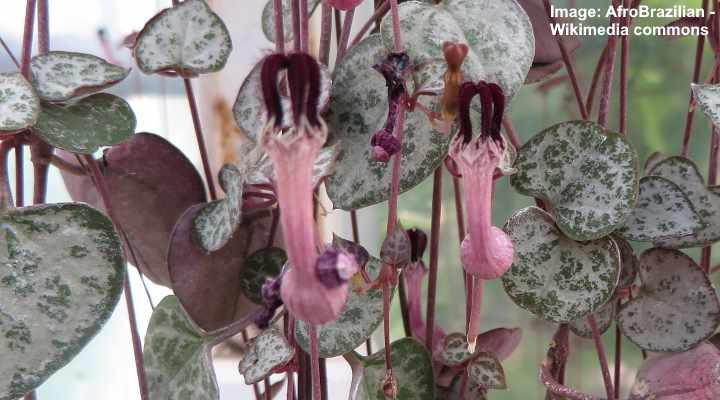
String of hearts plant (Ceropegia woodii) with flowers
String of hearts is a species of flowering plant in the genus Ceropegia. The fast-growing vining plants are native to South Africa and grow outdoors in USDA zones 10 and 11. Most people grow string of hearts in hanging baskets as tender houseplants.
Ceropegia woodii is a type of caudiciform plant—they have a tuberous root system. The tubers absorb and store water, making rosary vines somewhat resistant to drought. Over time, the tuber root can grow so large that it fills the pot.
Small tubers, looking like beads, also grow along the purple stems—hence the common name rosary vine. These small tubercles will take root if they touch the soil, making the delicate evergreen chain of hearts succulent extremely easy to propagate. Very quickly, you will have a new plant with thin, pendulous wispy vines and dangling heart-shaped leaves.
String of hearts (Ceropegia woodii) has a host of other common names. As well as rosary vine, other names include bushman’s pipe, necklace vine, wine-glass vine, lantern flower, and parachute flower. The thin, delicate leaves get easily tangled—so, the plant is also called hearts entangled.
Variegated String of Hearts (Ceropegia woodii f. variegata)
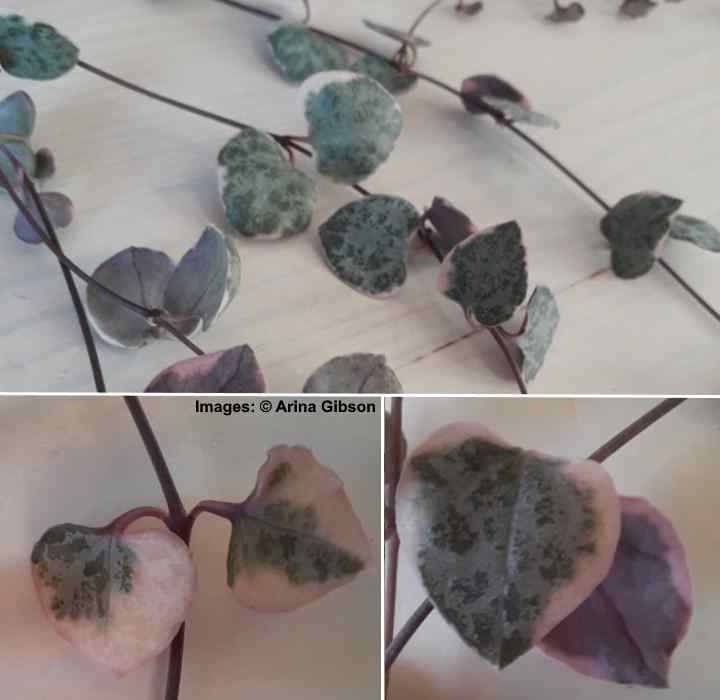
Variegated string of hearts
Variegated string of hearts is a delightful houseplant with cascading trailing vines. The outstanding feature of variegated string of hearts is their pink and cream coloring on dark green leaves. The colorful leaves and small flowers dangling on purples stems make the variegated Ceropegia species a great talking point.
String of Hearts Flowers

A close up picture of string of hearts flower
String of hearts is a flowering succulent that has intriguing tubular flowers, called corollas. The flowers of string of hearts plant look like small magenta-colored cylinders with a bulbous base. Deep purple fuzzy tops join the petals’ tips, that fuse to create a tent or canopy.
String of heart flowers are 1” (2.5 cm) long.
The genus name of string of hearts plant—Ceropegia—refers to the shape of a string of hearts’ flower, literally meaning ‘wax fountain.”
How to Care for String of Hearts (Ceropegia woodii)
String of hearts plants are easy-to-care-for houseplants that require indirect sunlight, occasional watering, and average room temperatures.
Here is how to care for a string of hearts plant.
String of Hearts Plant Light Requirements

Grow string of hearts plant in bright light away from direct sunlight
The string of hearts thrives in bright light, protected from direct sunlight. These delicate succulent plants need a few hours of sunlight. But too much sun can cause the leaves to wither. It’s best to keep them a few feet away from a south-facing window to prevent sunburn.
When a string of hearts gets enough bright light, you’ll notice that their delicate leaves are dark green with distinctive silver or light green markings.
Chain of hearts plants can survive in low light; however, that’s not recommended. If the trailing houseplant doesn’t get enough light, the leaves will lose their silvery marbling effect. Also, the variegated string of hearts leaves may lose their pink and cream markings in low light.
How to Water String of Hearts Plants

To care properly for your string of hearts plant, avoid overwatering it and only water when the soil has dried out
Only water a chain of hearts plant when the soil has dried out. In summer, you may have to water the drought-tolerant plant weekly. However, in winter, cut back watering to monthly or less. The best guide for watering a string of hearts is to test the soil for dryness.
There should be no moisture in the soil when you water a rosary vine. The plant’s tuberous roots store water and take a long time to dehydrate. In fact, string of hearts plants have more chances of dying from overwatering than underwatering.
The best way to water a sweetheart vine is to give the soil a thorough soak. Deeply watering the roots ensures that the thick fleshy roots get enough moisture. As long as you allow the soil to dry between waterings, the plant will be healthy and grow fast.
To water a string of hearts, you should pour enough water in the pot until it drains out the bottom. Allow all the excess water to drip out. Then, place the plant pot back on a drip saucer and put it in a bright location.
One of the common houseplant watering mistakes is to water often and a little. Frequent watering in dribs and drabs deprives the succulent roots of essential moisture. Also, you create a damp environment in the soil that can be a breeding ground for fungus gnats or cause white mold to develop on the soil’s surface.
It’s important to remember that how often you should water a string of hearts depends on the following factors:
- Climate—Hot, arid weather dries out the soil faster. You will have to water a string of hearts more frequently in hot weather, perhaps more often than once a week.
- Pot—Soil in terracotta plant pots evaporates faster than plants growing in plastic or glazed ceramic ones.
- Season—Like all houseplants, the string of hearts growth slows down in winter. This means you have to water less in winter than in summer.
The Best Soil for Growing String of Hearts Succulents
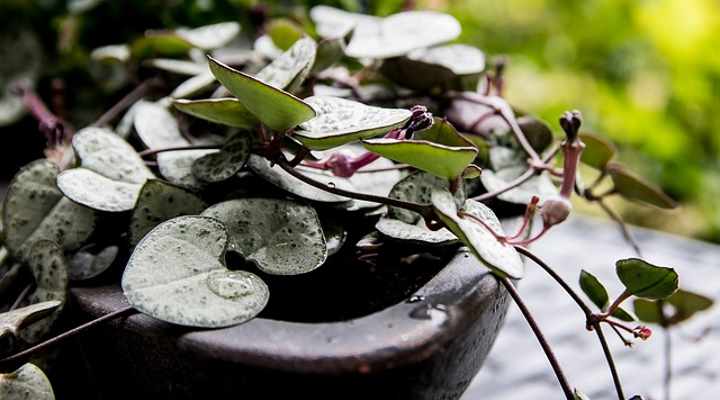
String of hearts grows best in a well-draining, light, aerated potting mix. Combine one part compost, one part perlite, and one part coarse horticultural sand. Mix well to create an ideal growing medium for the string of hearts. A soil mix for cactus or succulents is suitable for growing rosary vines.
The best type of soil for houseplant vines like chain of hearts needs to retain some moisture. Organic matter such as peat moss helps to keep the succulent roots hydrated. However, water needs to drain quickly so that the soil doesn’t become overly damp. Soil amendments to improve drainage are perlite, coarse sand, pumice, crushed granite, or poultry grit.
Whatever type of soil you use, ensure that it drains well. The potting mix should quickly dry out between watering to prevent the string of hearts from ‘standing’ in wet, soggy soil.
Related reading: Easy DIY potting mix recipes for houseplants.
Temperature Requirements for String of Hearts Plant Care Indoor
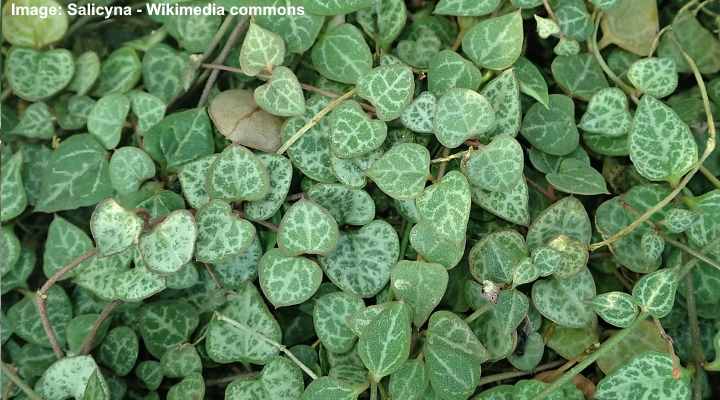
The best temperature range for string of hearts plant is between 70° and 85°F (21° – 29°C)
Rosary vines thrive in average room temperatures. The best temperature range for growing rosary vine houseplant is between 70° and 85°F (21° – 29°C). This temperature is close to the native tropical climate where the plants grow outdoors. The minimum temperature for these plants is 55°F (12°C).
It’s essential to protect the delicate string of hearts from temperature extremes. So, they should grow away from radiators or furnaces in winter when the heating is on. Also, keep them out of cold drafts—for example, in summer, when the air-conditioning is on, or there are open windows or doors.
If you live in temperate climates, you can grow string of hearts plants outdoors in summer. Place the potted houseplant in partial shade on a patio, deck, or balcony. Allow the sweetheart vine to get some sunshine daily but protect from the midday sun.
String of hearts can occasionally handle temperatures below 40°F (4°C). However, it’s best to bring the potted vining plants indoors when average outdoor temperatures are around 60°F (15°C).
Chain of Heart Plant Humidity Needs
String of hearts plants don’t need much humidity to survive. Like many succulents, these plants prefer low humidity. So, the dry indoor air of average homes is ideal for a string of hearts to grow well. If your home is especially humid, you can water the houseplant vine less often.
How to Fertilize String of Hearts
Fertilizing the rosary vine occasionally during the growing season can help it to grow faster. Use a regular houseplant fertilizer diluted to half-strength. At the most, apply fertilizer once a month during spring and early summer. Hold off fertilizing your houseplant in fall and winter when plant growth becomes dormant.
If possible, use a high-quality organic fertilizer. Natural plant “food” such as liquid seaweed and kelp, worm castings, or tea drops promote healthy plant growth. The best natural, organic fertilizers help avoid a mineral salt buildup in the potting mix that can damage the plant’s roots.
Pruning Rosary Vines (String of Hearts)
String of hearts only requires pruning to trim the thin pendulous stems shorter. To prune the vines, use a sharp clean pair of scissors to snip the stem to the desired length. The other reasons for pruning rosary vines are to propagate new plants or remove leggy stems.
String of hearts vines can grow up to 13 ft. (4 m) long in ideal conditions. However, at home, the thin dangling vines usually reach a maximum length of around five feet (1.5 m) indoors. So, pruning will be necessary at some point as the “heart strings” become longer.
How to Propagate String of Hearts
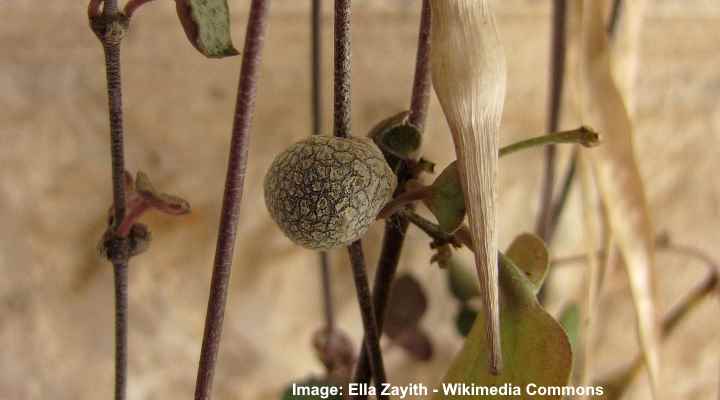
An air tuber of Ceropegia woodii can take root when placed on top of the soil and be used to propagate the plant
You can easily propagate string of hearts plants by taking some cuttings. Put the cut ends in a jar of water, and wait until they root. You can also put the plant cuttings on top of the soil as the small bead-like tubers of chain of hearts will quickly take root.
The other way of propagating a new string of hearts plant is to place the growing stems on a shallow tray of succulent soil. If necessary, untangle the vines and lay them on the soil tray, ensuring the tubers are touching the soil. Mist the soil regularly to keep it slightly moist. When roots appear, and leaves on the new plant start growing, trim off the stem and plant it in a pot.
Repotting String of Hearts
String of hearts needs repotting every two years in spring or early summer. Choose a pot that is one or two sizes larger to encourage more growth. If you want to maintain your current plant’s size, replant in the same pot using a fresh potting mix for succulents.
To repot a string of hearts, gently remove the tuber from the pot. Remember to take care of the delicate stems as they can easily break off. Check the rosary vine’s roots for signs of decay and remove any diseased sections. Repot in an appropriate-sized pot with fresh potting soil and water thoroughly.
Pests Affecting String of Hearts Growth
String of hearts are hardy plants and resistant to most houseplant bugs. However, mealybugs can become a nuisance with succulents—including the string of hearts. You can spot mealybugs by the cotton wool-like substance they leave behind. You may also notice some of these pests crawling under leaves.
There are several ways to get rid of mealybugs from rosary vines. Make a neem oil spray by mixing two teaspoons of organic neem oil and one teaspoon of mild liquid dish soap with one quart (1 liter) of water. Put the ingredients in a spray bottle and mix well. Spray your string of hearts with the neem oil solution weekly to get rid of the pesky bugs.
A natural way of eradicating mealybugs and other houseplant pests is by washing the plants in the shower. The spray of water should be enough to dislodge the crawling pests. At the same time, you will rinse off dust from the delicate heart-shaped leaves.
Diseases Affecting String of Hearts Plants
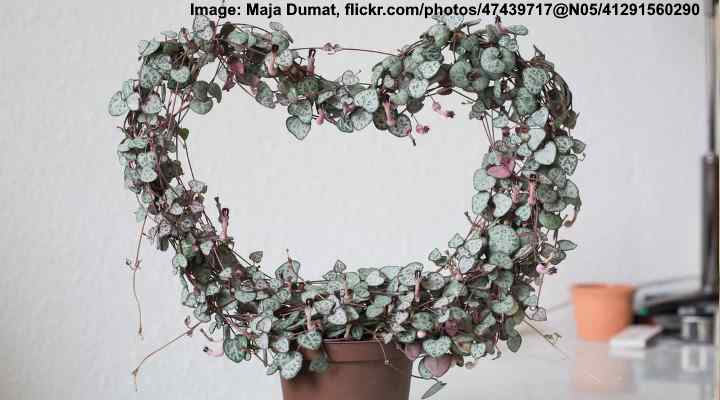
Overwatering string of hearts houseplant can cause fungal or bacterial diseases
Overwatering is the cause of most diseases that affect the chain of hearts plants. Soggy, damp, or wet soil cause fungal or bacterial infections. Succulent roots that stand in saturated soil become mushy, diseased, and start decaying. The best way to prevent disease roots is to water the plant properly.
If you care for a string of hearts plant by never overwatering it, the beautiful houseplant vine will grow for many years. You will soon have long trailing delicate stems with heart-shaped leaves growing at regular intervals.
Are String of Hearts Toxic Houseplants?
No, there is no evidence that Ceropegia woodii or string of hearts is toxic to cats or dogs. The California Poison Control System lists heart vines, hearts entangled, and hearts-on-a-string in the list of nontoxic plants for animals and humans.
FAQ
Easy-care string of hearts generally poses no growing issues. However, there are some things to be aware of that can affect the succulent plant’s health.
Why is my string of hearts dying?
Overwatering is the main reason rosary vines or chain of hearts die. Signs that the trailing houseplant is stressed are droopy, weak growth, and wilting leaves. Before the leaves start to wilt, they may turn yellow.
To save a dying string of hearts, resolving any watering issues is crucial. So, hold off watering until the soil dries. If your plant doesn’t revive, you may need to repot it in fresh soil. When repotting, check the roots for signs of rot and trim as necessary.
It’s vital that you only water string of hearts succulents when the soil is almost completely dry.
Why are my string of hearts leaves turning yellow?
The most common cause of a yellowing string of hearts plants is overwatering. The other reason is low temperatures. If you water the plant correctly, move your plant to a warmer location. Yellow leaves can appear on the thin vines in room temperatures below 60°F (16°C).
Related Articles:
